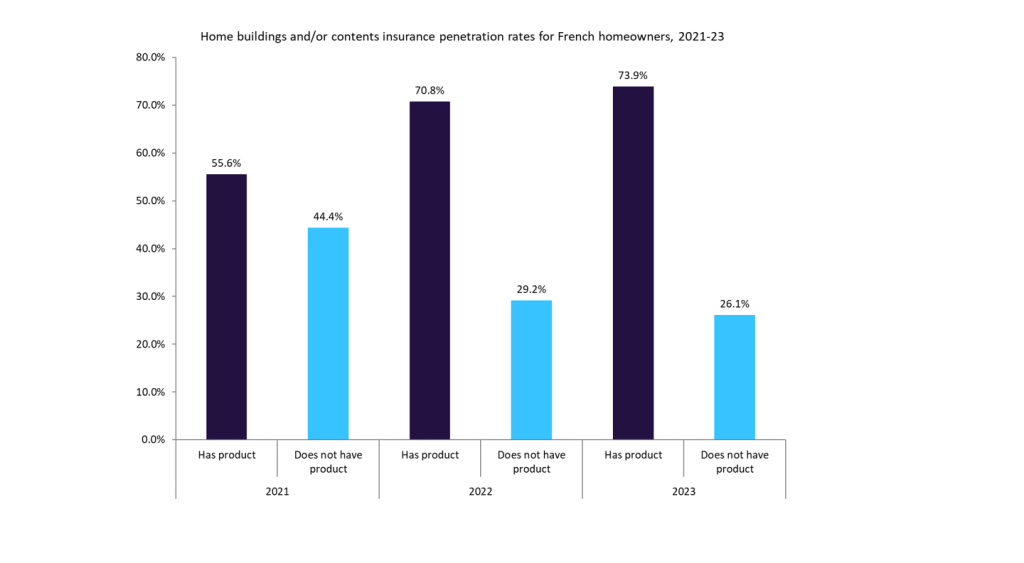Industry Attractiveness
The Slovak insurance industry’s gross written premium fell from EUR2.1 billion (US$3.1 billion) in 2008 to EUR2.0 billion (US$2.6 billion) in 2012. The decline was primarily due to the adverse affect on the Slovak economy of the 2008 global financial crisis. However, the economy entered a period of recovery in 2010. On average, Slovaks spend EUR400.0 (US$530.3) on insurance annually, compared to Austrians who spend EUR2,000.0 (US$2,651.5). Coupled with the fact that 20.0% of Slovak households were uninsured as of 2013, the potential growth opportunities are considerable. The industry’s gross written premium is expected to increase from EUR2.0 billion (US$2.6 billion) in 2012 to EUR2.4 billion (US$3.3 billion) in 2017.
There is considerable scope for the expansion of the life insurance segment due to rising levels of disposable income and an increase in life expectancy. Furthermore, the cover offered by the state pension is considered to be inadequate. The gross written premium registered by the life insurance segment increased from EUR1.0 billion (US$1.6 billion) in 2008 to EUR1.11 billion (US$1.0 billion) in 2012. This is expected to increase EUR1.4 billion (US$1.9 billion) in 2017.
The non-life segment, particularly the motor insurance category, is characterized by intense competition. The motor insurance category’s gross written premium declined between 2008 and 2012 due to competitive pressures. The property category’s gross written premium is rising due to an increase in demand for residential property insurance. This is due to heightening public awareness of the benefits of coverage following recurrent flooding. The segment’s gross written premium decreased from EUR939.0 million (US$1.4 billion) in 2008 to EUR847.6 million (US$1.1 million) in 2012. It is expected to increase to EUR943.1 million (US$1.3 million) in 2017.
The potential of the health insurance category is uncertain, given the present government’s decision to expropriate the assets of, or nationalize, the country’s two private insurers, Dovera and Union, which provide public health insurance services. The gross written premium registered by the personal accident and health segment increased from EUR57.3 million (US$83.9 million) in 2008 to EUR57.5 million (US$73.9 million) in 2012. It is expected to rise to EUR73.5 million (US$102.5 million) in 2017.
Segment Outlook
The life segment is the largest in the Slovakian insurance industry, accounting for 55.1% of the gross written premium in 2012. The gross written premium registered by the segment increased from EUR1.1 billion (US$1.6 billion) in 2008 to EUR1.11 billion (US$1.4 billion) in 2012. It is expected to reach EUR1.4 billion (US$1.9 billion) by 2017.
The insurance industry and life segment were adversely affected by the 2008 financial crisis and subsequent economic contraction in 2009, with a rise in policy cancellations and delayed premium payments. The gross written premium registered by the life segment, therefore, registered a decline in 2009. The economic recovery started in 2010 and meant that the life segment was once again on the rise. Domestic consumption is still depressed due in part to the high unemployment rate of 13.4% in 2012. This continues to negatively impact the life segment, which grew at a CAGR of only 0.3% between 2008 and 2012.
The growth of the life segment will continue to track the economy. One of the reasons for this is the popularity of unit-linked insurance products, whose performance is mainly determined by stock market performance. The stock markets reflect and track economic growth. The fact that the life segment registered a combined ratio of 90.8% in 2012 indicates that life insurers are registering underwriting profits. The combined ratio in the segment will continue to remain below 100% up to 2017, indicating that life insurers will continue to be profitable in their basic insurance operations.
The life segment is highly concentrated with the leading six insurers accounting for 74.4% of the market share in 2012. Allianz-Slovenska Pois?ov?a, AS was the segment leader with a 20.9% share, followed by Kooperative Pois?ov?a, AS, VIG with 20.7%.
According to a survey conducted in the second half of 2013 by life insurer ING Zivotna Pois?ov?a, AS, over one-quarter of Slovaks believe that one life-insured partner is adequate for their needs. Of the total respondents, 43% preferred the partner with the higher income to be insured, and 34% specifically want the male partner to be insured, primarily because the average salary is higher for men.
Life insurers in Slovakia primarily segment consumers on the basis of age. The three segments are the 0-17 years age group, the 18-65 years age group, and those above 65 years of age. For those in the youngest age group, insurance products are primarily aimed at creating savings for the insured, to be used on reaching adulthood. The products also aim at protecting the child in the event of death or permanent disability of the parent. For those aged 18-65 years, products mainly combine endowment insurance and cover for death and permanent disability. Annuity and pension products are also mainly targeted at this segment. People aged above 65 years are generally ignored by life insurers.
Key Industry Trends and Drivers
Slovakia has a three-pillar pension insurance system. The first pillar is a mandatory public pension insurance scheme is a pay-as-you-go mechanism, managed by the state-run Social Insurance Agency (SIA). It is funded mainly by the pension insurance contributions of economically active citizens on the following basis:
– 18% of the gross wage, if they have enlisted only under the first pillar
– 9% of the gross wage, if they have enlisted under both first and second pillars
The minimum insurance period required to be eligible for a retirement benefit is 15 years, where the individual concerned should have reached a pensionable age. The retirement age for men is 62 years, and the retirement age for women will also be 62 years by 2015. The contributions of those taking care of children aged six years and below are financed by the state. A disability pension fund is also administered by the SIA, to which the economically active must contribute 6% of their gross wage.
The second pillar is the mandatory private old-age pension saving scheme, managed by six private pension management companies. Since January 1, 2008, those born after December 31, 1986 have to decide within six months from the date of the start of pension insurance whether they will contribute 18% under the first pillar, or channel 9% into a personal pension account.
The third pillar is the voluntary private supplementary pension scheme, managed by five private supplementary pension companies. The widows or widowers of deceased insured individuals are entitled to receive 60% of the eligible pension, if the concerned individual was receiving a pension at the time of death. This is also subject to the fulfillment of certain other conditions.
Employers contribute 14% from the 18% of the gross wage, with 4% contributed by the employee. The 6% contribution towards disability insurance is equally shared between the employer and the employee. The self-employed, on the other hand, have to contribute the entire 18% and 6% on their own. Social insurance pensions traditionally fulfilled the demand for life insurance, but this is changing with rising demand for life insurance products partly due to rising life expectancy from 75 years in 2007 to 76 years in 2012. Social insurance pensions are increasingly perceived as not being enough to sustain a comfortable life, driving many to purchase life insurance products.
The growing economy and rising disposable income
The economy recovered from the 2008 financial crisis quicker than other eurozone countries. GDP rose and will continue to rise, primarily due to Slovakia being a strong manufacturing and export base for automobiles. Foreign direct investment (FDI) rose in the country as a result. The cumulative effect was a rise in per capita of gross national disposable income from EUR11,167.3 (US$16,358.1) in 2008 to EUR13,045.4 (US$16,771.1) in 2012. This increased income partially goes towards the purchase of life insurance products.
Increasing popularity of unit-linked products
Unit-linked products accounted for 32.3% of the gross written premium registered by the life segment in 2012. Life expectancy increased from 75.2 years in 2008 to 76 years in 2012, which, as with increased disposable income, drove Slovak customers to seek means to increase the value of their savings.
Distribution Channels
The distribution network for life products comprises agencies, direct marketing, brokers and e-commerce.
Agencies are the main distribution channel for life segment policies in Slovakia. For instance, Kooperativa Pois?ov?a, AS VIG has around 420 agencies, whereas Komunalna Pois?ov?a, AS VIG has around 80. Agencies accounted for 57.1% of the total commission paid to distribution channels in 2012. The value of gross written premium from new business collected through agencies, decreased from EUR284.7 million (US$417 million) in 2008 to EUR268.4 million (US$345.1 million) in 2012, at a CAGR of -1.5%. This value is projected to reach RON361.7 million (US$504.6 million) by 2017. The market share of agencies, in terms of gross written premium from new business, is expected to decline from 57.1% in 2012 to 56% in 2017. The number of new policies sold by brokers increased from 2.26 million in 2008 to 2.34 million in 2012. The number of new policies sold by agencies is expected to reach 3.18 million in 2017.
Direct marketing followed agencies in terms of the gross written premium from new business registered by the life segment in 2012. Direct marketing for life insurance comprises channels such as branch offices, sales representatives, call centers and insurers’ websites. There is a rise in the use of direct marketing channels by life insurers. Pois?ov?a Slovenskej Sporite?ne, AS, Vienna Insurance Group adapted several of its life insurance products in 2012 to ensure that they could be sold online. The Uniqa Group in Slovakia has around 500 sales representatives.
Direct marketing accounted for 37.2% of the total commission paid to distribution channels in 2012. The value of gross written premium from new business collected through the channel increased from EUR110.9 million (US$162.5 million) in 2008 to EUR174.9 million (US$224.8 million) in 2012, at a CAGR of 12.1%. Direct marketing accounted for 37.2% of the gross written premium from new business in 2012. This is expected to reach 38.3% in 2017, accounting for gross written premium from new business of EUR247.4 million (US$345.1 million) in the same year. The number of new policies sold through agencies increased from 881,773 in 2008 to 1.5 million in 2012. This number is expected to reach 2.2 million by 2017.
The value of gross written premium from new business collected through brokers decreased from EUR55.8 million (US$81.8 million) in 2008 to EUR22.6 million (US$29.1 million) in 2012, at a CAGR of 20.2%. It is, however, expected to reach EUR30.3 million (US$42.3 million) by 2017. Brokers accounted for 4.8% of the gross written premium from new business in 2012. This is expected to reduce to 4.7% by 2017. The number of new policies sold through brokers decreased from 444,031 in 2008 to 196,785 in 2012. The number is expected to reach 296,724 in 2017, at a CAGR of 8.6%. The broker companies that Kooperativa Pois?ov?a, AS regularly works with are Capitol, Respect Slovakia sro, Liberta AS, Insia SK sro, Concorde sro, Antares Risk sro., UniCredit Broker sro, Universal maklersky dom AS and ING Pavol Dudas Poinfo.
The value of gross written premium from new business collected through e-commerce increased from EUR2.6 million (US$3.8 million) in 2008 to EUR4.3 million (US$5.5 million) in 2012, at a CAGR of 13.1%. It is expected to reach EUR6.2 million (US$8.6 million) by 2017. E-commerce accounted for 0.9% of gross written premium from new business in 2012. This is expected to go up to 1% by 2017. The number of new policies sold through e-commerce increased from 20,728 in 2008 to 37,084 in 2012. The number is expected to reach 57,004 by 2017, at a CAGR of 9%.
How well do you really know your competitors?
Access the most comprehensive Company Profiles on the market, powered by GlobalData. Save hours of research. Gain competitive edge.

Thank you!
Your download email will arrive shortly
Not ready to buy yet? Download a free sample
We are confident about the unique quality of our Company Profiles. However, we want you to make the most beneficial decision for your business, so we offer a free sample that you can download by submitting the below form
By GlobalDataPorter’s Five Forces Analysis
Bargaining Power of Suppliers: Low
Bargaining Power of Buyers: Low
The bargaining power of buyers of life insurance products is assessed to be medium. The protective net provided by the social security system raises the bargaining power of average Slovaks in terms of life insurers. However, the leading six insurers accounted for 74.4% of the segment in 2012, indicating the market preference for products offered by these insurers. This raises the bargaining power of these six leading insurers.
Barriers to Entry: Low
The presence of multinational insurers in the country’s life segment indicates that the barriers to entry are low. A 100% FDI in the country’s insurance industry is allowed, subject to the fulfillment of certain conditions. The insurers headquartered in the other EU member states, can conduct insurance business in Slovakia without authorization under the Freedom of Services Policy. This is subject to the insurer being granted permission by the supervisory authority of the home member state, and a written notification from it to the National Bank of Slovakia.
Intensity of Rivalry: Medium to High
The intensity of rivalry in the life segment is assessed as medium to high. Overall, 74.4% of the segment is held by the leading six insurers. This is accentuated by the fact that demand for life insurance products is increasing.
Threat of Substitution: Medium
The threat of substitutes to life insurance is assesses as low. Although the country has a social security system, demand or life products is growing as disposable incomes and pilfer expectancy rise.







